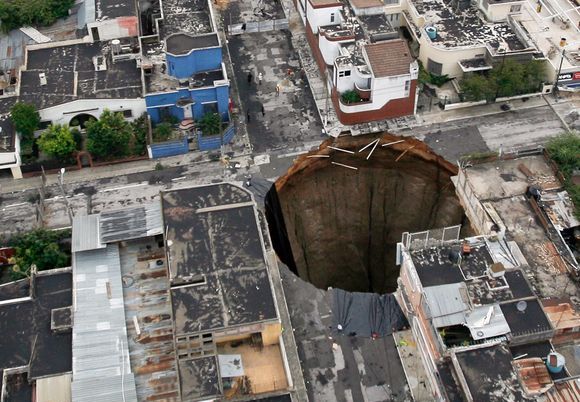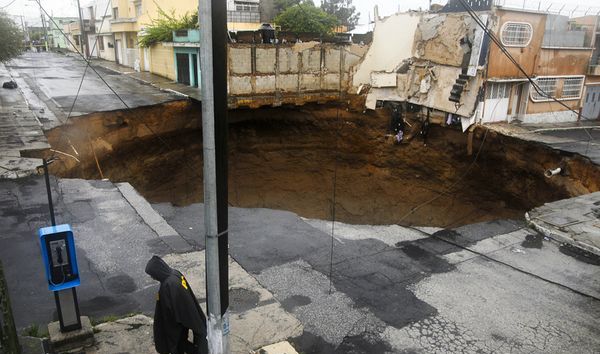危地马拉“天坑”之谜(双语)
爱思英语编者按:一场暴雨过后,危地马拉城惊现骇人“天坑(sinkhole)”。无独有偶,2007年时该城也曾因地面下陷出现过类似巨型地洞。有专家表示,该天坑的形成并非自然现象,极可能是人为所致。不过,到底是什么原因使得地洞形成,目前还是一个谜。

地质专家表示,危地马拉城街道上出现的天坑可能不是自然因素造成的,而是人为活动的结果。
Human activity, not nature, was the likely cause of the gaping sinkhole that opened up in the streets of Guatemala City, a geologist says.
美国新罕布什尔州达特茅斯学院地质学家萨姆•博尼斯称,可能是由于地下管道爆裂或雨水排放下水管道渗水,在地下掏出一个洞穴,最终导致这个塌陷洞形成。
A burst sewer pipe or storm drain probably hollowed out the underground cavity that allowed the chasm to form, according to Sam Bonis, a geologist at Dartmouth College in New Hampshire.
据估计,危地马拉城天坑宽60英尺(18米),深300英尺(100米),看起来是受到热带风暴“阿加莎”强降水的影响而形成的。
The Guatemala City sinkhole, estimated to be 60 feet (18 meters) wide and 300 feet (100 meters) deep, appears to have been triggered by the deluge from tropical storm Agatha.

不过地洞形成的首要原因是与该城和它的地下排水设施所在的位置有关,其地表以下深达数百米的地层主要是由之前火山爆发产生的浮石填充物构成。
But the cavity formed in the first place because the city—and its underground infrastructure—were built in a region where the first few hundred meters of ground are mostly made up of a material called pumice fill, deposited during past volcanic eruptions.
博尼斯说:“许多情况下,火山浮石大多是由(像沙砾一样松散的)流动性粒子形成的,它们在高温和重压下结合在一起,变成固体岩石。”
"Lots of times, volcanic pumice originates as a flow [of loose, gravel-like particles], and because of the heat and the weight, it becomes welded into solid rock," Bonis said.
他提到:“危地马拉城的(浮石)非常松散,至今仍未形成坚硬的岩石,因此很容易被侵蚀,尤其易受快速流动的水体影响。”
"In Guatemala City [the pumice is] unconsolidated, it's loose," he said. "It hasn't been hardened into a rock yet, so it's easily eroded, especially by swift running water."
总的来说,危地马拉城的地区规划条例和建筑法规非常薄弱,为数不多的几项规章制度也常常被忽视。也就是说泄漏的下水管道长期得不到维护,为这种天坑的形成创造了先决条件。
In general, the zoning regulations and building codes in Guatemala City are poor, Bonis said, and the few regulations that exist are often ignored. That means leaking pipes could have gone unfixed long enough to create the right conditions for the sinkhole.
事实上,博尼斯认为把危地马拉城地洞称作天坑并不恰当,因为真正的天坑完全是一种自然现象。他表示,关于危地马拉发生的这一切,目前还没有相关科学术语,他建议暂且先把这个地洞称作一种管道系统特征。
In fact, Bonis thinks calling the Guatemala City chasm a sinkhole is a misnomer—a true sinkhole is an entirely natural phenomenon. There is no scientific term for what happened in Guatemala, he said, adding that he recommends the pit be dubbed a piping feature.
此“天坑”非彼“天坑”
Guatemala Sinkhole Not a Sinkhole
“天坑”形成方式通常有两种情况:一是水分饱和的土壤,由于重量过大致使地下石灰岩洞穴无法承受,造成顶部坍塌;或者因为水流导致石灰石岩床上的天然裂缝变宽。
Natural sinkholes generally form when heavy, water-saturated soil causes the roof of an underground limestone cavity to collapse, or when water widens a natural fracture in limestone bedrock.
博尼斯称,但是在危地马拉城新“天坑”形成的地方并没有石灰石岩床,至少在这个洞穴的深度范围内不存在石灰岩。
But there is no limestone beneath the section of Guatemala City where the new sinkhole appeared, at least not at the depth at which the hole formed, Bonis said.
他说:“石灰岩可能存在于城下数千米深的地方,而不是深几百米的地方。”
"There may be limestone thousands of meters beneath the city, but not hundreds of meters," he said.
但是自然因素反而可能加速了人类活动引起的地面塌陷进程。
Instead, nature likely sped up a process set in motion by human actions.
博尼斯表示,最近危地马拉当地数座火山爆发,整个城市都蒙上一层厚厚的火山灰。如果火山灰进入城市的管道和排水沟里,可能会造成堵塞,极易引起管道爆裂。 更多信息请访问:http://www.engbus.cn/
Recent eruptions of several volcanoes in Guatemala covered the city in a fresh layer of volcanic ash. If this material got into the city's pipes and drains, it may have clogged the passageways, making ruptures more likely, Bonis said.
博尼斯推测,热带风暴“阿加莎”带来的强降雨,同时也加重了地下排水管道的负担,致使不断变大的地下洞穴最终塌陷。
Heavy rains from tropical storm Agatha may also have overloaded underground sewage or drainage pipes, leading to a growing cavity that eventually collapsed, Bonis speculated.
相关词汇
cavity 洞
chasm 裂缝, 裂口
deluge 大雨, 暴雨
deposite 沉积
erode 侵蚀, 腐蚀
hollow out 挖空
infrastructure 基础设施, 基础结构
particle 微粒, 颗粒
pumice 浮石
sewer pipe 污水管
sinkhole 污水坑
storm drain 暴雨水沟,暴雨下水道
tropical storm 热带风暴
volcanic eruption 火山爆发